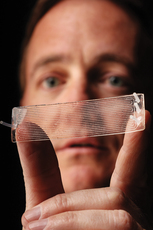Aug 8 2007
Networks of small, permanently mounted sensors could soon check continuously for the formation of structural defects in I-beams and other critical structural supports of bridges and highway overpasses, giving structural engineers a better chance of heading off catastrophic failures.
 Dennis Roach with a Comparative Vacuum Monitoring (CVM) device showing galleries etched into the sensor's underside.
Dennis Roach with a Comparative Vacuum Monitoring (CVM) device showing galleries etched into the sensor's underside.
A Sandia National Laboratories team is developing and evaluating a family of such sensors for use on a variety of safety-critical structures. Full-time monitoring sensors already have been tested and proven by Sandia for use on aircraft structures.
Over time, the stresses on a bridge caused by traffic, weather, and construction can result in the formation of tiny cracks in the steel and concrete structures of bridges. Exposure to wind, rain, and other elements can cause corrosion that can become a structural concern as well.
Like nerve endings in a human body, permanently mounted, or in-situ sensors offer levels of vigilance and sensitivity to problems that periodic checkups cannot, says Dennis Roach, who leads the Sandia team.
Structural health monitoring (SHM) techniques, as they are called, are gaining acceptance in the commercial aviation sector as a reliable and inexpensive way to alert safety engineers to the first stages of defect formation and give them the earliest possible warning that maintenance is needed.
With sensors continually checking for the first signs of wear and tear, engineers can detect cracks sooner, do the right maintenance at the right time, and possibly prevent massive failures, he says.
Sandia is a National Nuclear Security Administration laboratory.
Where flaws form
Sandia’s SHM work is an extension of its decades of research in non-destructive inspection (NDI) technologies currently used in manual inspections of commercial aircraft — to scan for small cracks in the airframe, for example. Such inspections are strictly regulated to maintain a high degree of aircraft safety
The SHM sensors being developed or evaluated at Sandia can find fatigue damage, hidden cracks, erosion, impact damage, and corrosion, among other defects commonly encountered in bridges.
The Sandia team already has developed or evaluated several types of inexpensive, reliable sensors that could potentially be mounted on important infrastructure, typically where flaws are expected to form.
“If I usually get fatigue damage in a particular area, that’s where I am going to install a sensor,” Roach says.
One promising SHM sensor, a Comparative Vacuum Monitoring (CVM) sensor, is a thin, self-adhesive rubber patch, ranging from dime- to credit-card-sized, that detects cracks in the underlying material. The rubber is laser-etched with rows of tiny, interconnected channels or galleries, to which an air pressure is applied. Any propagating crack under the sensor breaches the galleries and the resulting change in pressure is monitored.
The CVM sensors — manufactured by Structural Monitoring Systems, Inc. (SMS) — are inexpensive, reliable, durable, and easy to apply, says Roach. More important, they provide equal or better sensitivity than is achievable with conventional inspection methods and can be placed in difficult to access locations, he says.
Some other sensors being considered include flexible eddy current arrays, piezoelectric transducers that can interrogate materials over long distances, embedded fiber optics, and conducting paint whose resistance changes when cracks form underneath.
Smart structures possible
“When we set out to do NDI, in the back of our minds we knew that eventually we wanted to create smart structures that ‘phone home’ when repairs are needed or when the remaining fatigue life drops below acceptable levels,” Roach says. “This is a huge step in the evolution of NDI.”
“These sensors have been tested and shown to detect defects and fatigue in metal structures where safety is of utmost concern,” says Roger Hartman, manager of Sandia’s Infrastructure Assurance and NDI Department.
By combining networks of sensors of various types with other advanced materials work Sandia has done, such as using composite materials to repair damage to a highway bridge or watching for the first signs of fatigue using computerized prognostics and health management algorithms, “you begin to evolve a system approach to making important infrastructure elements safer and more reliable,” Hartman says.
Ultimately, a structural engineer might plug a laptop or diagnostic station into a central port on a bridge to download structural health data. Eventually “smart structures” fitted with many sensors and augmented with PHM algorithms could self-diagnose and signal engineers that repairs are needed or that they will be needed in a defined time downstream.
Sandia already is investigating applying SHM to a variety of structures. In addition to bridges and aircraft, SHM techniques could be used to monitor the structural well-being of spacecraft, weapons, rail cars, oil recovery equipment, pipelines, buildings, armored vehicles, ships, wind turbines, nuclear power plants, and fuel tanks in hydrogen vehicles, Roach says.
“There is widespread recognition that SHM’s time has come, an opinion you would not have heard from many people a few years ago,” he says.
Sandia is a multiprogram laboratory operated by Sandia Corporation, a Lockheed Martin company, for the U.S. Department of Energy’s National Nuclear Security Administration. Sandia has major R&D responsibilities in national security, energy and environmental technologies, and economic competitiveness.